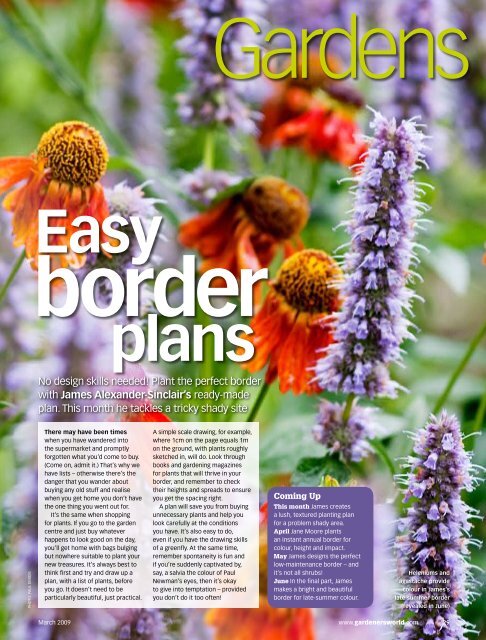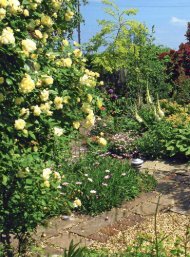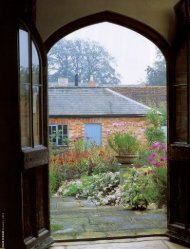Plant the perfect border with James Alexander-Sinclair's
Plant the perfect border with James Alexander-Sinclair's
Plant the perfect border with James Alexander-Sinclair's
- No tags were found...
Create successful ePaper yourself
Turn your PDF publications into a flip-book with our unique Google optimized e-Paper software.
Gardens<br />
Easy<br />
<strong>border</strong><br />
plans<br />
No design skills needed! <strong>Plant</strong> <strong>the</strong> <strong>perfect</strong> <strong>border</strong><br />
<strong>with</strong> <strong>James</strong> <strong>Alexander</strong>-Sinclair’s ready-made<br />
plan. This month he tackles a tricky shady site<br />
photo: paul debois<br />
There may have been times<br />
when you have wandered into<br />
<strong>the</strong> supermarket and promptly<br />
forgotten what you’d come to buy.<br />
(Come on, admit it.) That’s why we<br />
have lists – o<strong>the</strong>rwise <strong>the</strong>re’s <strong>the</strong><br />
danger that you wander about<br />
buying any old stuff and realise<br />
when you get home you don’t have<br />
<strong>the</strong> one thing you went out for.<br />
It’s <strong>the</strong> same when shopping<br />
for plants. If you go to <strong>the</strong> garden<br />
centre and just buy whatever<br />
happens to look good on <strong>the</strong> day,<br />
you’ll get home <strong>with</strong> bags bulging<br />
but nowhere suitable to plant your<br />
new treasures. It’s always best to<br />
think first and try and draw up a<br />
plan, <strong>with</strong> a list of plants, before<br />
you go. It doesn’t need to be<br />
particularly beautiful, just practical.<br />
A simple scale drawing, for example,<br />
where 1cm on <strong>the</strong> page equals 1m<br />
on <strong>the</strong> ground, <strong>with</strong> plants roughly<br />
sketched in, will do. Look through<br />
books and gardening magazines<br />
for plants that will thrive in your<br />
<strong>border</strong>, and remember to check<br />
<strong>the</strong>ir heights and spreads to ensure<br />
you get <strong>the</strong> spacing right.<br />
A plan will save you from buying<br />
unnecessary plants and help you<br />
look carefully at <strong>the</strong> conditions<br />
you have. It’s also easy to do,<br />
even if you have <strong>the</strong> drawing skills<br />
of a greenfly. At <strong>the</strong> same time,<br />
remember spontaneity is fun and<br />
if you’re suddenly captivated by,<br />
say, a salvia <strong>the</strong> colour of Paul<br />
Newman’s eyes, <strong>the</strong>n it’s okay<br />
to give into temptation – provided<br />
you don’t do it too often!<br />
Coming Up<br />
This month <strong>James</strong> creates<br />
a lush, textured planting plan<br />
for a problem shady area.<br />
April Jane Moore plants<br />
an instant annual <strong>border</strong> for<br />
colour, height and impact.<br />
May <strong>James</strong> designs <strong>the</strong> <strong>perfect</strong><br />
low-maintenance <strong>border</strong> – and<br />
it’s not all shrubs!<br />
June In <strong>the</strong> final part, <strong>James</strong><br />
makes a bright and beautiful<br />
<strong>border</strong> for late-summer colour.<br />
Heleniums and<br />
agastache provide<br />
colour in <strong>James</strong>’s<br />
late-summer <strong>border</strong><br />
(revealed in June)<br />
March 2009<br />
www.gardenersworld.com<br />
29
gardens<br />
Part 1<br />
<strong>Plant</strong>ing in shade<br />
In any planting situation, you need<br />
to realise <strong>the</strong> limitations. Assuming<br />
<strong>the</strong> ideal is a warm, sunny <strong>border</strong>, few<br />
of us actually have gardens that are<br />
not disadvantaged in some way.<br />
The most common problem we<br />
suffer is shade. Almost everybody has<br />
a shady corner of which <strong>the</strong>y despair.<br />
True, it’s rubbish for sunbathing and<br />
many plants will not enjoy living <strong>the</strong>re,<br />
but <strong>the</strong>re are positives – lots of plants<br />
that hate hot sunshine will flourish<br />
in a bit of cover. No situation is<br />
too dreadful and no conditions too<br />
extreme – <strong>the</strong>re are plants that will<br />
grow anywhere, from <strong>the</strong> tops of<br />
windswept hillsides to <strong>the</strong> deepest<br />
and scabbiest bogs. It’s just a matter<br />
of searching <strong>the</strong>m out.<br />
There are certain things you must<br />
sacrifice in order to plant successfully<br />
in shade. The main thing is colour.<br />
Almost every brightly hued plant<br />
needs sun. But don’t lose hope –<br />
<strong>the</strong>re are many things that will be<br />
happy under trees or in <strong>the</strong> lee of<br />
houses. Think subtle greens <strong>with</strong><br />
interesting textures and shapes.<br />
These combined <strong>with</strong> <strong>the</strong> odd shining<br />
white flower should do <strong>the</strong> trick.<br />
Dig in lots of compost, manure or leafmould. It’s vital to add<br />
1 organic matter to your <strong>border</strong> before planting to give new<br />
plants <strong>the</strong> best start. If shade is caused by trees, <strong>the</strong> soil will be<br />
poor because <strong>the</strong>y suck nutrients and water from <strong>the</strong> ground.<br />
Divide geraniums to make more plants – a decent specimen can often be<br />
2 chopped in half. When buying plants, look for <strong>the</strong> biggest and healthiest.<br />
Not only will <strong>the</strong>y do better than <strong>the</strong> weaklings, but you can divide some plants<br />
straight away. And that has to be good – two plants for <strong>the</strong> price of one!<br />
Position plants according to your plan but don’t worry if it<br />
3 needs a bit of tweaking, it’s <strong>the</strong>re as a guide. If you only see<br />
<strong>the</strong> <strong>border</strong> from one side, group more plants in your sightline.<br />
Don’t plant too near large trees because of <strong>the</strong>ir shallow roots.<br />
Border plan<br />
To give your design a<br />
naturalistic look, place<br />
plants in groups of three,<br />
five or, in fact, any odd<br />
number. One or two plants<br />
alone can look dotty.<br />
Key to plants<br />
N<br />
Sarcococca confusa<br />
Geranium macrorrhizum<br />
Epimedium x youngianum<br />
‘Niveum’<br />
Anemone x hybrida<br />
‘Honorine Jobert’<br />
Get planting! Add a handful of bone meal, general-purpose or granular slowrelease<br />
fertiliser to each planting hole. For pot-bound plants, tease apart<br />
4<br />
any tightly entwined roots <strong>with</strong> your fingers. When all <strong>the</strong> plants are in <strong>the</strong><br />
ground, lay a mulch of organic matter to suppress weeds and retain moisture.<br />
Water in new plantings – you should always do this, even<br />
5 if it’s raining. In a bed like this it would be sensible to keep<br />
watering for <strong>the</strong> first season. The plants will tell you if <strong>the</strong>y are<br />
thirsty because <strong>the</strong>y’ll go all droopy and wan, so listen to <strong>the</strong>m.<br />
Dryopteris erythrosora<br />
Helleborus orientalis<br />
Geranium phaeum<br />
factfile<br />
Total cost of plants<br />
£117.90<br />
Luzula nivea<br />
When planting any new <strong>border</strong>, dig it over<br />
and add compost or o<strong>the</strong>r organic matter<br />
Plan scale 1:50<br />
photos: paul debois. illustration: james alexander-sinclair<br />
The plants will fill out once<br />
6 established to create a<br />
flourishing <strong>border</strong> <strong>with</strong> plenty<br />
of colour, shape and texture.<br />
Time to prepare<br />
ground Two hours<br />
Time to plant<br />
Two hours<br />
Time to full<br />
maturity<br />
Two years<br />
Location<br />
Problem shady<br />
areas, any soil types<br />
30 www.gardenersworld.com<br />
March 2009 March 2009 www.gardenersworld.com 31
gardens<br />
Helleborus<br />
orientalis<br />
Sarcococca<br />
confusa<br />
Anemone x hybrida<br />
‘Honorine Jobert’<br />
Dryopteris<br />
erythrosora<br />
Geranium<br />
phaeum<br />
<strong>Plant</strong>s for our shade <strong>border</strong><br />
I chose <strong>the</strong>se plants to give as much<br />
interest as possible for most of <strong>the</strong><br />
year, including a good mixture of<br />
texture, foliage and flower. They<br />
all came in 2-litre pots. This is <strong>the</strong><br />
standard nursery size and big enough<br />
to house a decent-size plant, <strong>with</strong>out<br />
being too expensive. They were all<br />
sourced from a local nursery and cost<br />
£4.80 each (<strong>with</strong> <strong>the</strong> exception of <strong>the</strong><br />
sarcococca, which cost £7.50).<br />
They’re not big enough to give<br />
instant coverage, but in a couple of<br />
years… If you can’t wait that long,<br />
it’s easy to fill <strong>the</strong> gaps <strong>with</strong> annuals.<br />
White busy Lizzies will lighten <strong>the</strong><br />
gloom as will pansies, Nicotiana<br />
sylvestris and forget-me-nots. Bulbs<br />
such as crocus and <strong>the</strong> species Tulipa<br />
turkestanica are also good fillers.<br />
Adapting <strong>the</strong> plan<br />
Sarcococca<br />
confusa x 1<br />
An evergreen shrub <strong>with</strong> tiny<br />
flowers that smell like George<br />
Clooney’s aftershave (although<br />
I can’t verify this fact!).<br />
Height 1.8m x spread 1m.<br />
Geranium<br />
macrorrhizum x 3<br />
An excellent low-growing plant<br />
<strong>with</strong> pinky flowers and autumn<br />
colour. Its only drawback is a<br />
faint smell of cat pee.<br />
Height 50cm x spread 60cm.<br />
Epimedium x<br />
youngianum ‘Niveum’ x 3<br />
A low-growing evergreen <strong>with</strong><br />
persil-white flowers and slightly<br />
Obviously it doesn’t matter if you don’t have a <strong>border</strong> this<br />
shape because <strong>the</strong>se plants will be fine in any shady part<br />
of your garden. If you have a larger area, use more plants,<br />
say five where we have suggested three. If your <strong>border</strong> is<br />
smaller, <strong>the</strong>n pick your favourites from <strong>the</strong> list and go <strong>with</strong><br />
<strong>the</strong>m. If you have a very small <strong>border</strong>, it’s best to stick <strong>with</strong><br />
<strong>the</strong> evergreen varieties in this plan ra<strong>the</strong>r than dotting<br />
around one of each variety.<br />
Also, try and stick to <strong>the</strong> order of <strong>the</strong> plants. The lowergrowing<br />
ones are much better at <strong>the</strong> front and <strong>the</strong> geranium<br />
and dryopteris will fare best in your darkest, poorest spot.<br />
coy blushing to <strong>the</strong> leaves<br />
in spring and autumn.<br />
Height x spread 30cm.<br />
Anemone x hybrida<br />
‘Honorine Jobert’ x 3<br />
Pure-white flowers <strong>with</strong> eggy<br />
centres in late summer. The<br />
leaves are semi-evergreen.<br />
Spreads slowly and inexorably<br />
to take over Wiltshire.<br />
Height 90cm x spread 60cm.<br />
Dryopteris<br />
erythrosora x 5<br />
A semi-evergreen fern, <strong>with</strong><br />
a slight coppery tinge to<br />
<strong>the</strong> fronds, it is an excellent<br />
variety for <strong>the</strong> <strong>border</strong>.<br />
Height 50cm x spread 35cm.<br />
Coping <strong>with</strong> trees<br />
L Trees drain <strong>the</strong><br />
surrounding area<br />
of nutrients, so dig<br />
in a generous amount<br />
of organic matter<br />
before planting, and<br />
every autumn, too.<br />
L The area next to<br />
<strong>the</strong> trees will be dry<br />
because of <strong>the</strong>ir<br />
hungry roots and<br />
overhanging branches,<br />
so make sure that you<br />
water any new plants<br />
well and keep a<br />
careful eye on <strong>the</strong>m<br />
in hot, dry wea<strong>the</strong>r.<br />
L Trees often have<br />
roots close to <strong>the</strong><br />
surface, which can<br />
make planting difficult.<br />
Try and work your plan<br />
Helleborus<br />
orientalis x 3<br />
The Lenten rose has white,<br />
plum or a sort of greenish flower<br />
in late winter and early spring.<br />
Height x spread 45cm.<br />
Geranium<br />
phaeum x 3<br />
Also known as <strong>the</strong> mourning<br />
widow. Deep blackcurranty<br />
coloured flowers in May.<br />
Height 75cm x spread 50cm.<br />
Luzula<br />
nivea x 3<br />
Woodrush, a slowly spreading<br />
grassy evergreen <strong>with</strong> small<br />
white flowers in summer.<br />
Height x spread 45cm.<br />
around <strong>the</strong>m as<br />
much as you can.<br />
L Beware of lime<br />
trees, which are<br />
susceptible to aphids<br />
that will drip gunk<br />
on your plants.<br />
L In autumn, make<br />
sure fallen leaves<br />
don’t smo<strong>the</strong>r your<br />
young plants.<br />
photos: gap photos/fhf greenmedia, jonathan buckley, jo whitworth, mark bolton; paul debois<br />
32 www.gardenersworld.com March 2009

















